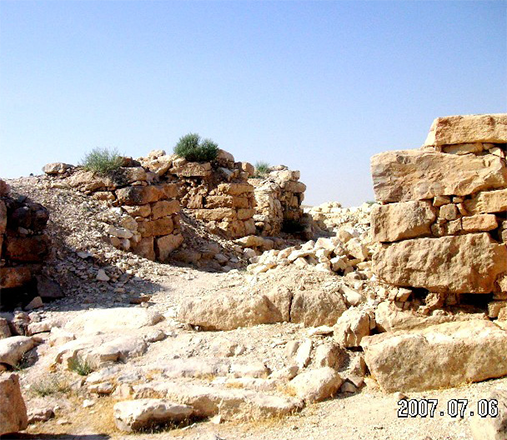You are here
Ancient cultic sites of Transjordan: Studying Tell Deir Alla’s case
By Saeb Rawashdeh - Mar 09,2024 - Last updated at Mar 09,2024

The inked plaster text from the Iron Age found at Deir Alla (Photo courtesy of ACOR)
Archaeologists and historians sometimes struggle to interpret remains of such structures because of the lack of written sources. Animal bones and remains of some kinds of food may indicate that a certain structure was a shrine or a temple where cultic rites were performed. Also, votive objects, figurines and betyls can also highlight the religious character of such places.
“Figurines may have been used and are often found in domestic contexts and tombs,” noted a Dutch archaeologist Margreet Steiner, adding that the building may be the place where such objects were made, stored or sold, or maybe figurines were used not only as votive objects.
Arguing from cult practices (the placing of votives in a shrine) to archaeological finds (the presence of figurines in a building) is much more straight forward than arguing from the excavated remains (figurines in a building) to cult practices (so this building is a shrine), Steiner explained, adding that as the “backward trail” is hard to follow, archaeologists have to use the criteria that argue from cult practice to material culture, bearing in mind that other explanations are possible and should be examined.
The Transjordan was an area that had many cultic sites during the Iron Age, and it included temples and shrines. According to Steiner, eight possible Iron Age cult places (temples or shrines) have been excavated: three in the Jordan Valley (part of ancient Ammon), four in Moab, and one in Edom.
“These buildings have been identified as cultic by their excavators, followed sometimes by much scholarly discussion,” Steiner said.
In the Jordan Valley, the cult place is built at Tell Deir Alla, located south of Pella.
“In 1967, a large text, painted on the plaster of a wall, was found in a small building and the text refers to the seer Balaam, son of Beor, known from the Bible,” Steiner explained, adding that the plaster was found in two heaps east and west of the wall on which the text was supposedly written, thrown there when an earthquake struck the village around 800 BC.
Benches in a building are often seen as a sign of its cultic nature and the benched room is part of a complex of rooms and courtyards.
“All in all, some forty rooms have been excavated in this unwalled village, forming 14 to 15 households. Ordinary household wares, bread ovens, storage facilities, and loom weights were found in every household,” Steiner elaborated, adding that the benched room yielded no exotic or cultic materials, but some interesting finds were made in a nearby complex.
Moreover, north of the benched room was an open courtyard with three bread ovens. From this courtyard one entered a complex of three rooms in which 18 loom weights were excavated, the scholar said, noting that Boertien connects this weaving complex with the benched room and suggests that textiles were woven here for the goddess Shagar, the main goddess mentioned in the Balaam text.
“This interpretation is based on the special kind of textile made of hemp that was woven at Deir Alla and on a parallel with Kuntillet Ajrud, where another kind of rare textile was found in connection with a shrine. Near the entrance of the weaving complex north of the benched room, an inscribed stone was found as well as a goblet and a very large loom weight, which all may have had cultic functions,” Steiner highlighted.
The stone was inscribed with the benshar‘a (“stone of shar‘a”) and the same words were incised on a jug found in another room of this complex.
Interpretations of the benched room vary from a Balaam height or cultic cave where people could come into contact with the gods while dreaming (to a shrine for the goddess Shagar, with outliers such as a classroom for the teaching of scribes and “a meeting place of a group of prophets . . . were the visions and deeds of that Balaam were remembered”, Steiner maintained.
“Although the benched room and the building complex it belonged to did not yield many exotic or cultic materials, the benches, the special fabrics woven at the site, the inscribed stone and libation goblet and the outsize loom weight found in adjacent rooms as well as the content of the Balaam text undeniably point to the cultic nature of the building. There is no continuity with the Late Bronze Age temple excavated at the site which was located more to the west of the tell,” Steiner pointed out.
The Balaam inscription justifies the interpretation of the building as a shrine.
However, which rituals were performed in the shrine of Deir Alla remains unclear, Steiner concluded.
Related Articles
AMMAN — Pella, an ancient site located approximately 100 kilometres northwest from Amman, was discovered in 1818 by Charles Irby and James M
AMMAN — Thousands of animal bones, ceramic animal figurines, wall stones and limestone altars have been found at an Iron Age temple in Khirb
AMMAN — Khirbet Ataruz, located around 30 kilometres southwest of Madaba, represented an early Iron Age II temple with two building phases,


















